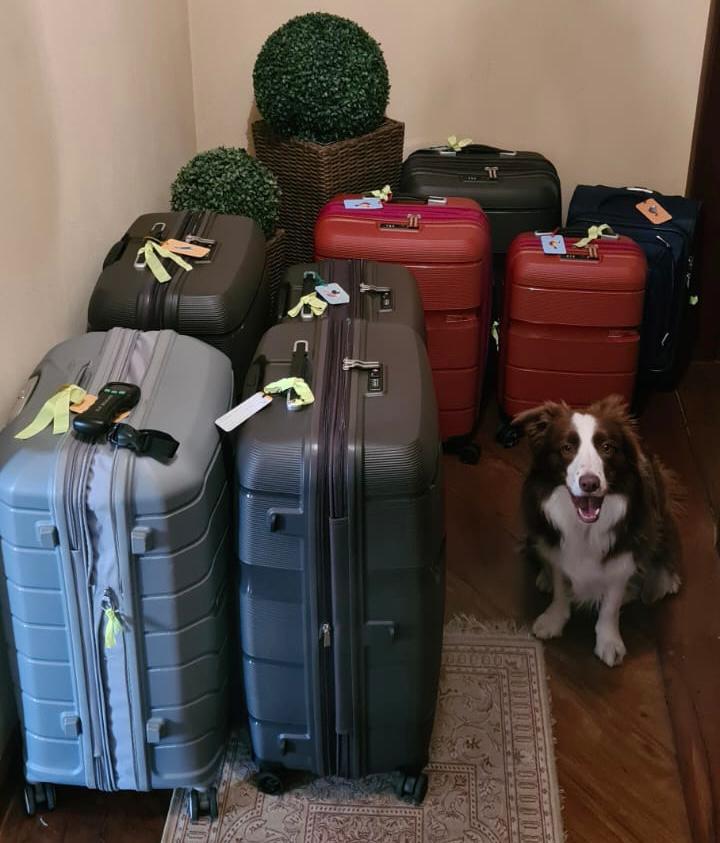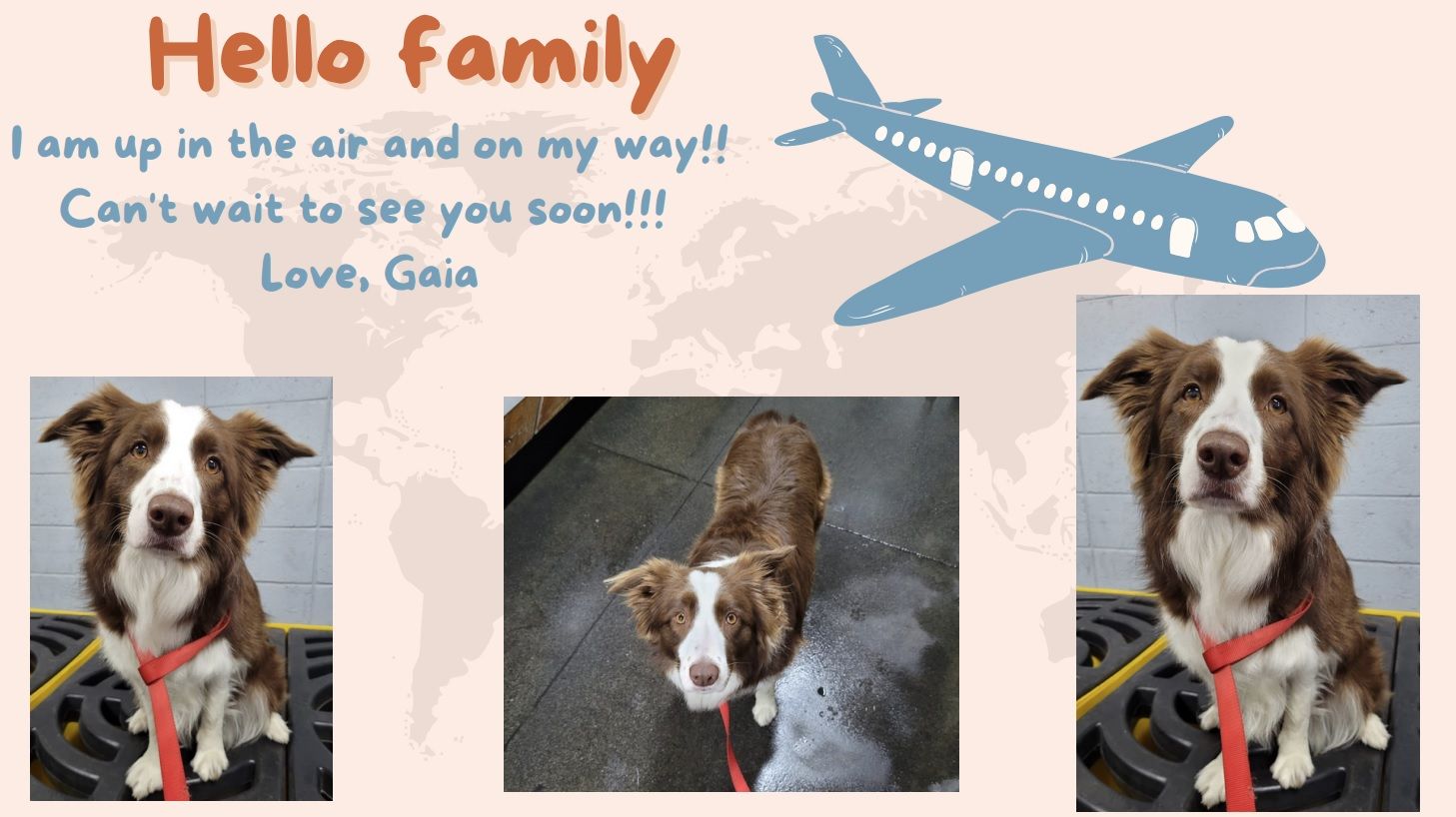Travelling by Plane with your Pet: DURING the Trip

In the first post of our series on air travel with your pet, we addressed the main questions that arise before your pet's trip (click here to access the first post).
Now it is time to talk about the precautions to be taken during the trip. Once again, we count on the collaboration of Carolina Neves, pet travel consultant and behaviourist of dogs and cats in Brazil*.
Sanitary requirements met, air tickets bought, documentation ready... it's time for the trip. And several concerns begin to arise. Can I give medicine for the pet to sleep? Has my pet already been boarded? Will the animal be well during the trip? Are they handling the crate delicately? Will the pet adapt quickly to its new home?
I won't lie, this was the most challenging part for us, as things are no longer under our control, especially since Gaia travelled unaccompanied. The company responsible for her journey picked her up at my parents' house in São Paulo in the morning and she was delivered to our house in London the following day, around lunchtime. We received some photos and updates about her trip during this period, but we were very apprehensive.
Still, some precautions can be taken before, during and after the trip to alleviate (at least a little) this anguish and help you and your pet go through it all more peacefully.

Days immediately before the trip
In the days immediately before the trip, it is important to think about some preventive measures, especially related to the pet's health, food and well-being. We asked Carolina to explain some of them:
"Even with great crate training, we have to think about the day before the trip and plan some processes one or two days before.
Intensifying energy-consuming activities that your pet is used to will help keep him calm during the trip - walks in quiet places, encouraging the dog to sniff in order to relax (if it can be in nature, even better).
The last walk or activity before the trip should be planned after the pet's last meal of the day, as the animal must be fasting during the trip. Food management will bring more comfort for travelling pets since they will have less desire to relieve themselves during the journey and also reduce the possibility of them having motion sickness without food in their stomachs.
It is important that the fasting plan is supervised by a veterinarian, according to the needs of each pet.
To avoid any unexpected gastric situations, it is a good idea to avoid offering foods and snacks different from the pet's usual diet a few days before the trip. Wet foods are an interesting option because they will help the pet to maintain hydration and greater digestibility throughout the journey."
The day of the trip
The day of the trip is the most difficult one since, except for pets travelling in the cabin, nobody will have access to your pet during the flight and you, unfortunately, have no way of knowing if it is sleeping or restless, calm or afraid. That's why training for the journey is so important, as we explained in the previous post.
As Gaia travelled via cargo, we received photos and updates from the company during the whole trip. They kept us posted every step of the way: she arrived at the airport, finished the pre-boarding procedures, was handed over to the airline, the flight took off, the flight landed, she arrived safely and is now at the Animal Reception Centre at Heathrow Airport (where she ate and relieved herself) and - finally - she is in the car on her way home.

Below, Carolina clarifies some doubts that many people have about the trip itself and gives other interesting tips that can help you and your pet that day.
"In general, a pet that travels in the hold of the aircraft will not be fed during the trip. There are some travel arrangements with longer stopovers in places that have a structure so that the pet can leave the carrier to relieve itself, rest and feed safely. But what is usually required is that the owner sends a portion of dry food on the crate, in addition to leaving feeding and drinking bowls attached to the door of the carrier, in case of emergency.
In the crate itself, it is allowed to place an absorbent pad, but toys, collars and harnesses are forbidden to avoid accidents. You can try to send a soft mattress or a piece of cloth with the scent of home in the crate, but there are no guarantees that the airline will allow it (or that they will not lose those items). In addition, it is essential to keep the pet's nails cut so that they do not get stuck in anything and end up hurting your pet.
It is also possible to put an Airtag (Apple's tracking device) on the carrier, as an extra safety item. It can be fixed on the outside of the crate, under transparent tape for easy identification. Despite not being 100% accurate with the location, as they relay their location information to nearby devices connected to Apple's Find My network, the Airtag can be one more tool to contribute to our peace of mind.
After the animal is delivered for boarding, it is common to question: 'Is my pet already on the plane?
We always suggest that the responsible person delivers a small letter with a photo of the pet to someone on the crew, asking them to confirm with the pilot if he/she is aware that your pet is on board and make sure to control the temperature and pressurization of the live cargo hold.
This is only possible when the pet travels accompanied (as excess baggage) and usually causes a very nice commotion on the flight crew.
Another important issue: many people believe that it is necessary to medicate the pet that will travel long distances, but this is extremely dangerous! Drugs for sedation in general, when used without criteria, can cause your pet to die.
Besides, some of these drugs cause only apparent sedative effects, but the animals continue to feel and suffer from stressful situations. In this case, however, the drug may deregulate the pets' vital signs, which causes them to forget the healthy parameters to deal with the situation itself.
The best remedy for such occasions is TRAINING!!! It is the only way to turn a challenging situation into a peaceful moment."
Upon arriving at the destination
My pet finally arrived home safely, so I can stop worrying now, right? Not quite... In fact, the worst part of the journey is over, but it is still important to monitor pets in the first days after their arrival and help them to adapt to the new place, home and routine. Always respecting each pet's pace.
In the first 24 hours, it is normal for the pet to present some signs of stress such as lack of appetite, anxiety, tiredness, joint stiffness, and jet lag, among others. That is why it is important to let pets rest and monitor them in general. Avoid over-feeding, over-hydrating or over-exercising pets upon their arrival.
Carolina gives some tips on what to do in these first days.
"The precautions do not end after the pet arrives at home. Remember that pets are not aware that they are in another city or country and that they will arrive at a new house, with different smells and sights, that their walks will be on different paths and that it may be colder or hotter than they are used to. Patience in this process is a key factor!
Try to reestablish the feeding, playing and walking routine of your pet. Slowly, without haste, respecting the time of each animal. There may be changes in their behaviour, and some opportunistic health issues, all due to all that changes and the stress of the whole process - for pets and humans alike.
During the first week, it is also important to find out about the specific rules of your destination for pets - some countries charge fees or require specific identification for owning animals. Ideally, try and gather as much information as possible before the trip.
Depending on the destination, there may be restrictions on some breeds, requirements that animals are sterilised, and even the prohibition of entry of any pet, depending on the country of origin.
The extra attention to your pet in the first weeks will be worth it when your routine is already structured and everyone starts enjoying this new adventure together."
We hope that these tips and information can help other humans and pets that are in the same travel process to go through this challenging experience more smoothly.
In the next post, we will talk about the main precautions to be taken after the trip, to facilitate the adaptation of your pet in the new home (click here).
*Carolina Neves is a dog and cat behaviourist in Brazil, founder of Consultoria Pet and has been working for 18 years directly helping families to understand and communicate better with their pets.

